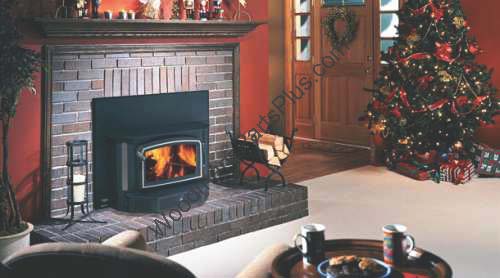The Regency i2400 is an excellent wood fireplace insert, and when properly maintained, it is capable of heating almost any size home. Regular upkeep is key to fireplace efficiency as well as safety; built up ash and creosote are at risk of catching fire, which can spread beyond your fireplace and chimney. To avoid this and keep your fireplace working at 100%, you’ll want to clean each section of your Regency i2400 on a regular basis.
What is a Wood Fireplace Insert?
A wood fireplace insert is a stove designed to slip into (insert) an existing masonry fireplace. Fireplace inserts also use insulated glass to close the system off, keeping the combustion contained and allowing blowers or vents to push hot air out into the home. Throughout the burning season, a fireplace insert will accumulate a black or brown residue called creosote on many of its internal components, including its baffles. Creosote is flammable, and can lower the efficiency of the fireplace.
What are Fireplace Baffles?
A fireplace baffle, is an essential component of a wood burning stove that sits at the top of the firebox. Made from metal materials that can withstand high temperatures, these plates keep air and gas inside the firebox. This helps increase heat production while also helping warm up a room in a more controlled manner. Like the rest of the fireplace, baffles will accumulate creosote if not cleaned regularly.
What You’ll Need to Clean Your Regency i2400
There are several items you’ll need to properly clean your Regency i2400 Wood Insert fireplace, including:
- Hot Water
- Glass Cleaner
- Paper Towels
- Ash Shovel
- Metal Bucket
- Brush attachment for vacuum
- Mask (N95 or better)
- Gloves
- Ash Vacuum (if possible)
- Regular vacuum (If you do not own an ash vacuum)
Use an ash approved vacuum, an ash vacuum is designed to withstand higher temperatures, and can handle a hot coal or small piece of burning wood. A regular vacuum, on the other hand, usually has a plastic or fabric bag. This means if you suck up anything that's still burning, it's likely to light on fire.
How to Clean Your Regency i2400 Fireplace
Step #1: Make Sure Your Stove is Off and the Glass is Cool
To start, make sure that you have not had a fire in your Regency i2400 for at least 24 hours, checking it carefully for any signs of heat or residual embers. Cleaning the stove while there is still any burning components within is dangerous, and can result in property damage or personal injury.
Step #2: Open and Scrub Window
Put on your mask and gloves, then soak a few paper towels in water and open the window to your fireplace. Dip the paper towels in a bit of ash before the initial wipedown; this will give the paper towels an abrasive quality. Once you’ve wiped away as much built up creosote as possible, get a new set of towels and wash it once more with just water. You can also use a glass cleaner recommended by the owner's manual or the manufacturer.
Step #3: Shovel Out the Ash
Place your metal bucket as close to your fireplace as possible and tilt it towards the firebox. This will ensure that the ash travels the smallest possible distance, reducing particulate matter in the air. Using your ash shovel, scoop out as much ash as possible.
Step #4: Vacuum the Remaining Ash
Using your
ash vacuum with brush attachment, carefully swipe the bottom of the glass door and outer edges of the fireplace. Then, go into the firebox and move back and forth across the surface to get any ash you could not scoop out. Take special care to vacuum the air inlet on the front of the firebox, which can clog and make your fireplace less efficient. If you use a regular vacuum instead of an ash vacuum, make sure to dispose of the bag after you are done, as it will be clogged.
Step #5: Check Your Fire Bricks
Before moving on to cleaning your baffles, check the fire bricks that line the backend of your fireplace. If you see any cracks or damage, make sure to replace them before you light another fire or before the next burning season. After that, you’ll begin to remove your baffles.
Step #6: Remove and Clean Your Baffles
There should be two baffles set above your firebox. Your owner’s manual will recommend that you remove the secondary air tube seated below these baffles. This will ensure they are not damaged, but can take much longer. If you are careful, you can also slide the baffles out without removing the tube. Push the right baffle back, being careful not to damage the tab on the front. Tilt the baffle and slowly slide it out. Repeat this process with the left baffle. Set the baffles on the bottom of your fire box, then vacuum all of the material build-up on top of each.
Step #7: Replace Any Broken Fire Bricks and Reset Baffles
Once everything is clean and you’ve replaced any cracked or damaged fire bricks, slide the baffles back in place. If you removed the secondary air tubes, put those back as well. Close the door of your insert, and give it a couple of hours for any residual glass cleaner to evaporate.
Regular Cleaning is a Good Habit, But You’ll Need an Inspection as Well
The National Fire Protection Association recommends that you have your wood fireplace inspected once per year to ensure it's functioning properly. Regular maintenance and upkeep is important, and keeping your fireplace clean is an essential part of wood fireplace ownership. But an annual inspection and sweep by a professional will not only clean the parts of your chimney you can’t reach, but identify small problems the average homeowner wouldn’t be able to spot.


/1003/site-assets/logo.png)


